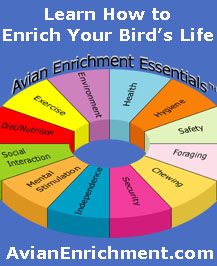Parrots in Culture
|
Parrots have captivated humans throughout the centuries with their beauty, intellect, personality, and highly social nature. The awe we feel towards these marvelous creatures has been reflected in many aspects of human culture. Specifically, human and bird relationships have expressed through legends, myths, religious teachings, literary writings, art, music, ceremonies, and other cultural activities. Here are a few examples of these expressions:
The Nazca Lines The Nazca Lines, discovered in 1927, are the most extraordinary legacy left by a culture that flourished over 2,000 years ago. One of the most famous drawings is of a parrot. These geoglyphs, are a series of complex designs, some miles long, which can only be seen in their true dimension from the sky. The pre-Columbian Nazca culture is not believed to have been capable of flight, but the question still remains as to how they crafted the drawings, what technology they used and what purpose the lines served. This style group is characterized by animal and human figures of very low precision, constructed using both the clearing method of removing desert pavement, and digging more pronounced trenches. These figures are placed on hillside inclines, probably to be viewed from the plateau floor as guide/directional-signs for trade routes. Many of the geoglyphs are constructed using a continuous line style: where a single line forms the complete figure without ever crossing itself. This has lead many scientists to believe that these symbols served a ceremonial purpose - that the people of these ancient cultures "walked" the lines to perform some ritual - starting at a point, then following the entire shape of the symbol until its end.
Petroglyphs The depiction of parrots in the petroglyphs are indications of the long distance trade routes between the native cultures of of the American Southwest. Among the birds pictured in rock art of the American southwest are the figures of some birds that are not native to North America but which had been imported from Meso-America, specifically Amazon parrots and macaws. These birds along with other items were imported from the jungles of southern Mexico, more than 600 miles to the south. Macaws in particular were of special, perhaps ceremonial, importance. Remains of macaws and parrots have been found in abundance at Chaco Canyon and other sites proving that not just the feathers, but the birds themselves had been traded for. There were basically two species of Macaw that were prehistorically imported into the American southwest from Mesoamerica. These are the Military Macaw (Ara militaris), and the Scarlett Macaw (Ara macao). Native American societies prized feathers for decorative purposes as well as for their perceived symbolic and spiritual meanings. For any people who highly prized feathers the feathers of Mexican macaws would have been valued highly indeed for the beauty of their bright colors. Pueblo peoples associated macaws with the rainbow because of their bright colors and, as birds, they belonged in the sky. The multicolored plumage of macaws also suggested the many colors of kernels found on Indian maize. Thus it is not surprising that macaw and parrot feathers were important for the creation of "Corn Mother" fetishes. Pueblo peoples create "Corn Mother" fetishes, based on a perfect head of corn bundled within a cluster of feathers. Macaw feathers were also highly prized for the creation of "prayer sticks."
The Mayan Creation Myth held an important role for the parrot: "In the beginning was only Tepeu and Gucumatz (Feathered Serpent). These two sat together and thought, and whatever they thought came into being. They thought earth, and there it was. They thought mountains, and so there were. They thought trees, and sky, and animals etc, and each came into being. But none of these things could praise them, so they formed more advanced beings of clay. But these beings fell apart when they got wet, so they made beings out of wood, but they proved unsatisfactory and caused trouble on the earth. The gods sent a great flood to wipe out these beings, so that they could start over. With the help of Mountain Lion, Coyote, Parrot, and Crow they fashioned four new beings. These four beings performed well and are the ancestors of the Quiché."
In many south Indian temples, the Goddess holds a parrot in her hand. The goddess Meenakshi, the "Fish-eyed" One. She is accompanied by a bird, usually a parrot.
Folktales Folktales featuring parrots have originated from England, Switzerland, France, Pakistan, Iran, Italy, Thailand, Mongolia and Ancient Egypt....just to name a few! Unfortunately, as folktales go, many have often don't have happy endings. Here are a few that turn out well for the parrot:
Many Buddhist stories have also featured parrots, here are a few examples:
Art & Music Pet birds have been depicted in many well known works of art and have even been honored with musical compositions:
Festivals Parrots are also celebrated through various festivals in their countries of origin:
May 31st marks the international holiday dedicated to celebrating parrots. World Parrot Day was founded by the World Parrot Trust in 2004 as an event to raise awareness of the threats to captive and wild parrots. |







































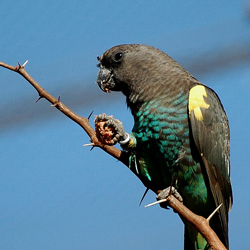



























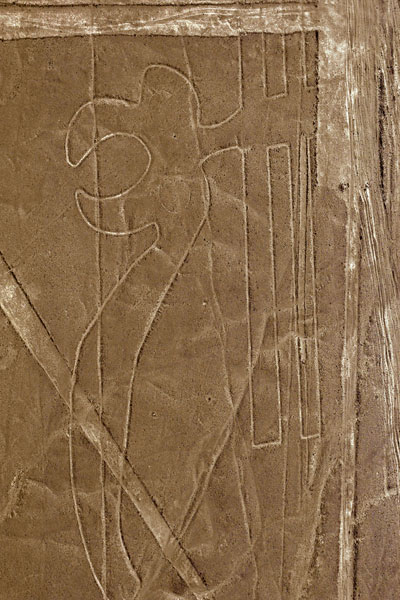
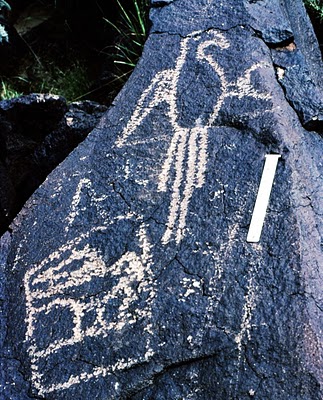
 In South America the brightly colored feathers of parrots, toucans, and macaws have been used to make headdresses since before the Spanish conquest in the sixteenth century. The use of feathers by indigenous peoples is ubiquitous throughout South America. The primary use of feathers is in the creation of ornamental ritual attire. Many of these cultures believe that feathers provide spiritual strength and protection. The Bororo tribe believes that birds are messengers between the terrestrial world and their ancestors in the spiritual world. This bright blue headdress is decorated with macaw feathers. It belonged to a chief and was collected between 1826 and 1829.
In South America the brightly colored feathers of parrots, toucans, and macaws have been used to make headdresses since before the Spanish conquest in the sixteenth century. The use of feathers by indigenous peoples is ubiquitous throughout South America. The primary use of feathers is in the creation of ornamental ritual attire. Many of these cultures believe that feathers provide spiritual strength and protection. The Bororo tribe believes that birds are messengers between the terrestrial world and their ancestors in the spiritual world. This bright blue headdress is decorated with macaw feathers. It belonged to a chief and was collected between 1826 and 1829.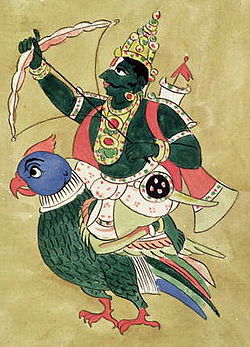
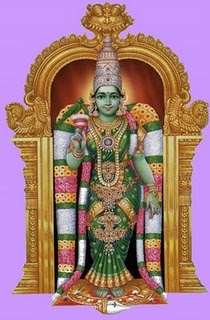 The Indian parakeet is a recurring theme in Indian mythology and folktales. The parrot in Hindu mythology is associated with Kama, the god of love. The reason for this could be its green feathers and red beak which associates it with fertility. Red beak represents the red earth before the rain and the green feathers represent the green earth after the rains. Red represents unfulfilled desire, full of yearning, while green represents fulfilled desire, full of joy. Kama is most often depicted as riding a parrot.
The Indian parakeet is a recurring theme in Indian mythology and folktales. The parrot in Hindu mythology is associated with Kama, the god of love. The reason for this could be its green feathers and red beak which associates it with fertility. Red beak represents the red earth before the rain and the green feathers represent the green earth after the rains. Red represents unfulfilled desire, full of yearning, while green represents fulfilled desire, full of joy. Kama is most often depicted as riding a parrot.
